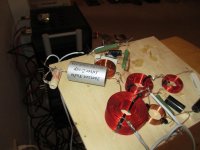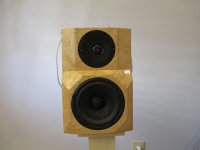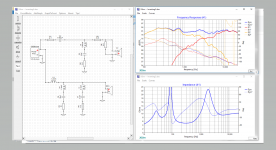The holy grail of audio is more details. Different components go about their own ways differently but we can generalize them in two basic ways - one good way and one bad way. The good way is to lower the noise floor to reveal more of the music or the other way of putting it is to have the
components give more resolution. The bad way is to artificially emphasize a certain band frequency to give the impression of more details. For example, some components emphasize the frequency band from 1khz to 3khz to make the sound slightly more forward but this is false detail. Every components
are guilty of the latter - some are more than others. The good ones have a lot more of the former, while the bad ones have a lot more of the latter. Nothing is perfect. Here are three basic
objective categories for judging:
1. Inherent resolution: that is how much details from the component own detail
2. False resolution: how much from artificial frequency emphasis
3. Transparency: if two components have similar 1&2 rating, the difference could be #3.
So we have here what we call entry level high end cap - Mundorf Supreme and Jantzen Silver-Z. Initially, I am a bit reluctant of buying the Silver-Z because I was afraid its just a bit of marketting hype from Mr. Gravenson aka Troels. I have been using Mundorf supreme for awhile and like it very much.
But I wanted to try something a bit different so I got a pair of Silver-Z. They are both 5.6uF.
The speakers are my DIY with the tweeters from Satori TW29RN-B and woofers from ScanSpeak 15W/4531G Revelator 5.5.
See pictures below.
3rd place: (a distant third) Clarity Cap SA.
I guess it's a nice entry level cap. Nothing offensive. But it has somewhat of a haze over the music. Treble a bit splashy and not quite as extended. Less 3 dimensional. Slightly overly warm.
1. Inherent resolution: 60/100
2. False resolution: 40/100
3. Transparency: 50/100
2nd place: Mundorf Supreme
The Mondorf by itself is very good. By comparison against the Clarity SA, it has more detail, more transparency, better top end without emphasizing anything. Everything is very natural. You could listen for hours. If this is the first high end cap you listen to, you probably would have thought it's as good as it gets, but of course there are better stuffs.
1. Inherent resolution: 80/100
2. False resolution: 20/100
3. Transparency: 70/100
1st place: Jatnzen Silver-Z
I thought the Mundorf was pretty good until I listen to the Silver-Z. It's just better in almost everyway. In my other post I mention the conception of "continuousness" and the Silver-Z sounds a bit more continuous. Vocal has a natural warmness and eveness. The Mundorf in comparision can sound a touch shouty. When I turn the volume up, the sound stays composed without sounding harsh. Image is more stable vs. the Mundorf and has more present and slightly more pin-point. I've read from Tony Gee website that this cap can sound slightly analytical in the wrong system and I could see that being silver but in my system it just sounds perfect. Treble is very smooth and in someway it is slightly warmer than the Mondorf. But is it guilty of adding any false resolution of its own? Slightly. I think in the upper end of the treble there is a slight emphasis so you have the impression of more "air" than it actually is but the effect is very subtle. I guess if your system is already
bright then it could be a problem but it mine I do not have any problem. Highly recommended.
1. Inherent resolution: 90/100
2. False resolution: 10/100
3. Transparency: 85/100
Now that I have listened to the Silver-Z, I'd like to try out the Alumen-Z version. It seems to have all the goodness of the Silver-Z without the slight emphasis on the upper treble based on what I've read. The price is not bad.
This leads to another point. Speaker designers tend to brag how much details their speakers have but now based on my discussion above, it's sort of silly. Details do not come from the xover design or any part of the design. Details come from the components themselves such as the drivers, capacitors, resistors and so on. The designer task is to make sure all the components perform together. The designers may decide to emphasize some frequncy spectrum to modify the sound but this is not the same as detail.
components give more resolution. The bad way is to artificially emphasize a certain band frequency to give the impression of more details. For example, some components emphasize the frequency band from 1khz to 3khz to make the sound slightly more forward but this is false detail. Every components
are guilty of the latter - some are more than others. The good ones have a lot more of the former, while the bad ones have a lot more of the latter. Nothing is perfect. Here are three basic
objective categories for judging:
1. Inherent resolution: that is how much details from the component own detail
2. False resolution: how much from artificial frequency emphasis
3. Transparency: if two components have similar 1&2 rating, the difference could be #3.
So we have here what we call entry level high end cap - Mundorf Supreme and Jantzen Silver-Z. Initially, I am a bit reluctant of buying the Silver-Z because I was afraid its just a bit of marketting hype from Mr. Gravenson aka Troels. I have been using Mundorf supreme for awhile and like it very much.
But I wanted to try something a bit different so I got a pair of Silver-Z. They are both 5.6uF.
The speakers are my DIY with the tweeters from Satori TW29RN-B and woofers from ScanSpeak 15W/4531G Revelator 5.5.
See pictures below.
3rd place: (a distant third) Clarity Cap SA.
I guess it's a nice entry level cap. Nothing offensive. But it has somewhat of a haze over the music. Treble a bit splashy and not quite as extended. Less 3 dimensional. Slightly overly warm.
1. Inherent resolution: 60/100
2. False resolution: 40/100
3. Transparency: 50/100
2nd place: Mundorf Supreme
The Mondorf by itself is very good. By comparison against the Clarity SA, it has more detail, more transparency, better top end without emphasizing anything. Everything is very natural. You could listen for hours. If this is the first high end cap you listen to, you probably would have thought it's as good as it gets, but of course there are better stuffs.
1. Inherent resolution: 80/100
2. False resolution: 20/100
3. Transparency: 70/100
1st place: Jatnzen Silver-Z
I thought the Mundorf was pretty good until I listen to the Silver-Z. It's just better in almost everyway. In my other post I mention the conception of "continuousness" and the Silver-Z sounds a bit more continuous. Vocal has a natural warmness and eveness. The Mundorf in comparision can sound a touch shouty. When I turn the volume up, the sound stays composed without sounding harsh. Image is more stable vs. the Mundorf and has more present and slightly more pin-point. I've read from Tony Gee website that this cap can sound slightly analytical in the wrong system and I could see that being silver but in my system it just sounds perfect. Treble is very smooth and in someway it is slightly warmer than the Mondorf. But is it guilty of adding any false resolution of its own? Slightly. I think in the upper end of the treble there is a slight emphasis so you have the impression of more "air" than it actually is but the effect is very subtle. I guess if your system is already
bright then it could be a problem but it mine I do not have any problem. Highly recommended.
1. Inherent resolution: 90/100
2. False resolution: 10/100
3. Transparency: 85/100
Now that I have listened to the Silver-Z, I'd like to try out the Alumen-Z version. It seems to have all the goodness of the Silver-Z without the slight emphasis on the upper treble based on what I've read. The price is not bad.
This leads to another point. Speaker designers tend to brag how much details their speakers have but now based on my discussion above, it's sort of silly. Details do not come from the xover design or any part of the design. Details come from the components themselves such as the drivers, capacitors, resistors and so on. The designer task is to make sure all the components perform together. The designers may decide to emphasize some frequncy spectrum to modify the sound but this is not the same as detail.
Attachments
How can these...
...be 'basic objective categories'?
1. Inherent resolution: that is how much details from the component own detail
2. False resolution: how much from artificial frequency emphasis
3. Transparency: if two components have similar 1&2 rating, the difference could be #3.
...be 'basic objective categories'?
When comparing parts like these I'm always disappointed that I don't ever see any baseline measurements of the parts themselves. Firsthand accounts based on personal opinion in such listening sessions are always easily disproven, and very subjective.
What does the frequency response of the capacitors themselves look like? What are the important perameters, such as ESL, ESR, and leakage? These are very important details when designing/implementing filter circuits, and to see them left out (especially for such allegedly "high end" components is unusual.
Maybe this belongs in the lounge? Since it verges on religion more than electrical theory?
What does the frequency response of the capacitors themselves look like? What are the important perameters, such as ESL, ESR, and leakage? These are very important details when designing/implementing filter circuits, and to see them left out (especially for such allegedly "high end" components is unusual.
Maybe this belongs in the lounge? Since it verges on religion more than electrical theory?
Religion is banned even in the lounge. Sadly, some threads try to avoid electrical theory too.
Having said that, the most likely place to genuinely hear differences between components of exactly the same value is a passive speaker crossover. It would have been helpful if the OP had given us capacitance measurements.
Having said that, the most likely place to genuinely hear differences between components of exactly the same value is a passive speaker crossover. It would have been helpful if the OP had given us capacitance measurements.
just to add a microreview for their lower end caps: I bought some 1uf Mundorf EVO, Jantzen Crosscap and Jantzen Standard. still have to try Mundorfs (will update later) but Im finding the Crosscap really pleasant and enjoyable, really lush, powerful, big sound.
The Standards are brighter (more neutral I suppose) and much more sterile sounding but slightly better in detail, its hard to tell if its just colouration but the Crosscap gives a much better sense of depth than the flatter sounding standards. I think for transparency you'd be better off going for superiors or better, Jantzen actually recommend the superiors or silvers for coupling on the crosscap page but no mention of standards
The Standards are brighter (more neutral I suppose) and much more sterile sounding but slightly better in detail, its hard to tell if its just colouration but the Crosscap gives a much better sense of depth than the flatter sounding standards. I think for transparency you'd be better off going for superiors or better, Jantzen actually recommend the superiors or silvers for coupling on the crosscap page but no mention of standards
Last edited:
. It would have been helpful if the OP had given us capacitance measurements.
That completely goes against the grain for the 'Glom for victory' brigade
"some components emphasize the frequency band from 1khz to 3khz"
Please explain this. Is there any boost in the frequency response? I would call it a design failure then.
If there is a boost in a certain frequency range, the cap is nonlinear and not really suitable for high fidelity application. There are plenty of proletariat-grade parts that exhibit very linear response and consistency, such that it amazes me the snake-oil filled gluten-free hemp paper types of caps are still so trendy
- Status
- This old topic is closed. If you want to reopen this topic, contact a moderator using the "Report Post" button.
- Home
- Design & Build
- Parts
- Mundorf Supreme cap vs. Jantzen Audio Silver - Z cap


